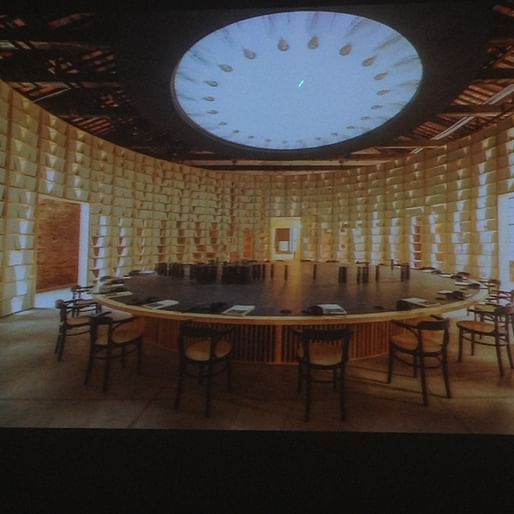

This week Bernard Khoury gave a lecture at the University of Miami School of Architecture as part of their ‘Currents’ lecture series. ‘Currents’ casts a wide net of different speakers with varying topics, but usually focused on work being done in the present. Dean Rodolphe el-Khoury gave a warm welcome to the lecture hall, introducing Bernard as a fellow Lebanese architect and Rhode Island School of Design Alumnus, and that in their native Beirut; Bernard has achieved a status of a “rock star” or “national treasure”.

Khoury (Bernard) began his lecture with a brief history of his life and his personal connections to war-torn Beirut. From 1975 – 1990 is engaged in a period of violence and upheaval, with various parts of the city suffering vast amounts destruction. The work he presents, whether academic, professional, or as visual art, is a reaction to the events that occurred and the ill-fated reconstruction plans that never materialized for the city. His academic project, “Evolving Scars”, is one such example. It is a project done while studying in the U.S., but is concerned with the concept of urban memory and the demolishing of structures left empty after the fighting.

He remarks that his return to Beirut was motivated by the expectation of working for the public sector to help with reconstruction efforts; during his academic years he states that success was measured by doing this type of work. Ironically, his earlier projects came from a completely different source: the entertainment sector. Khoury briefly introduces his first built work, the nightclub B018 in Beirut. Placed in the quarantine zone, this nightclub is little more than an underground bunker with untreated hydraulic steel plates that keep it concealed in the day time. When the sun sets, the plates open. One such plate reveals segmented mirrors on the underside that reflects the city back to the club goers. Khoury mentions that everything was custom and no contractor wanted to touch the project; he prefers it that way. Everything was designed specifically for the project, and he drew the construction drawings himself. The structure, which was supposed to have a lifespan of 5 years, is now on its 17th year and has had no structural or mechanical issues. He considers it a success, because it created a destination on a site with a long standing history of negative associations.

Over the course of the evening, he reinforces his responsive approach through other projects: a luxurious underground sushi restaurant that sits next to a dilapidated war torn building housing squatters, an experimental pod called POW 08 that serves as both, a transportation device for prisoners being returned to enemy lines and an intelligence gathering unit, the project Derailing Beirut that places a fictional roller coaster through the urban ruins of the city while passengers ride in bomb shape capsules which speak to the level of people being “passive actors” to the world around them, and an apartment building that creates connections between rooms of a unit and the street through its front façade. Most of the work presented can be found in Beirut.

Indeed much of Khoury’s works are in the Middle East, where he is very critical of the architecture in the area. He mentions that his style is representative of his indigenous knowledge of place. He claims that the “modernity” of buildings constructed in the Middle East and Asia are products of excess, with no connections to their surroundings or memory. “My success is not measured by the amount of square meters I build”, he states towards the end, “I don’t aspire to have an office of 200 people. I am proud to be a local.” His final project in the evening touches on this subject: the Bahrain Pavilion at the Venice Biennale. A circular bookshelf creates the walls of the room, with an overhead projector of the same person reciting the 22 different national anthems all at the same time. A table sits in the middle with documented evidence of modernist projects done around the Middle East and Asia from 1914-2014. His reasoning is that many of the buildings being created now are no different from the other and lack individuality. Some of the work produced recently are the result of the “globals” (i.e., giant corporate firms, starachitects, etc.), the firms that do not have a presence nor understand the culture of this area in the world. He claims that all they build are “just second or third rate replicas of things you might find out west”.

This blog gives a sneak peak into the architecture world at the University of Miami. What began as an experiment following one group of incoming graduate students through their first semester of design, has morphed into a window of the school of architecture through this professor's eyes. I will try to post as often as possible.
No Comments
Block this user
Are you sure you want to block this user and hide all related comments throughout the site?
Archinect
This is your first comment on Archinect. Your comment will be visible once approved.